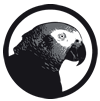
All About Parrots




























All About Parrots
Parrots are amazing birds, living jewels with the gift of communication with humans. They are also among the most intelligent of birds, with certain individuals functioning on a level similar to a three- to six-year-old human child. The larger species of parrots are also among the longest-lived birds, many having life expectancies as long as or longer than humans.
On the Wild Side
In the wild, parrots spend most of their time foraging for food, covering large areas during the day and returning to their nest or a common roost at night. They are opportunistic feeders, eating whatever they can find. Seeds, fruits, vegetables, and insects are all part of most parrots' diet
Flocks
Many parrots form flocks when they are not in the breeding season, ranging anywhere from a few individuals of a single species to large groups of several species. These flocks feed and roost together, keeping watch for predators from above and below. With their loud voices, parrots can keep in vocal contact with each other over long distances.
Mates
Most parrots in the wild mate for life, even going through a mourning period if they are separated from their mate. When breeding season comes around, each pair finds a suitable nest site. Larger birds prefer to nest in hollowed out tree trunks, often taking over old nest sites and modifying them by chewing through the wood with their strong beaks. Females lay a clutch of one or two eggs (more for smaller birds), which are incubated for about a month. When the chicks hatch, they still need a lot development. Depending on the size of the bird, eyes open and feathers start emerging on chicks anywhere between a few days to few weeks after hatching. Up until the time that the young birds take their first flight, the parents take turns feeding the chicks.
Beaks
Parrots have evolved with strong hooked beaks designed to aid them in chewing wood for their nesting sites, as well as allowing them to feed upon even the toughest fruits, nuts, and seeds. Unlike humans, parrots use their syrinx (lower larynx ) to form all words and sounds, a necessity as they don't have lips to form words with.
Your Parrot Guide
Are you thinking of getting a pet parrot and would like to know what's involved. Read all about it in our Parrot Care section.
Perhaps you already have a companion bird and would like to know more. Read about Training, First Aid, Diet, Behaviour and more in our Parrot Care section.
Read reviews of the most recent parrot publications hot off the press at our Parrot Books guide.
Would you like to learn about the work of Parrot Conservation?
You can read all about the different species of Parrot in our complete guide to Parrot Species.
For Fun Facts and Games with maybe an art project or two, head on over to our Kids Corner.
Newsletter
We'd love to hear from you and you can leave your comments or sign up for the All About Parrots monthly newsletter. It's packed with the latest parrot news, tips and views for parrot lovers everywhere. If you would like to send us your parrot stories and pictures perhaps you or your parrot could feature in our next issue.